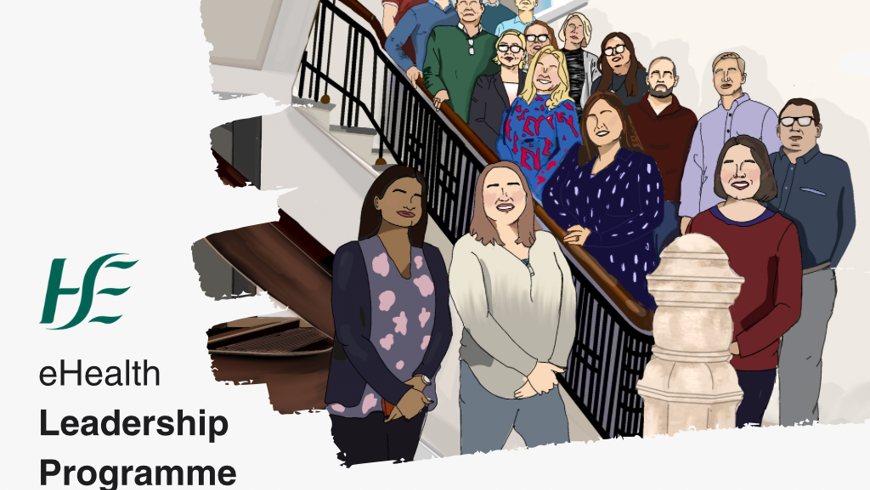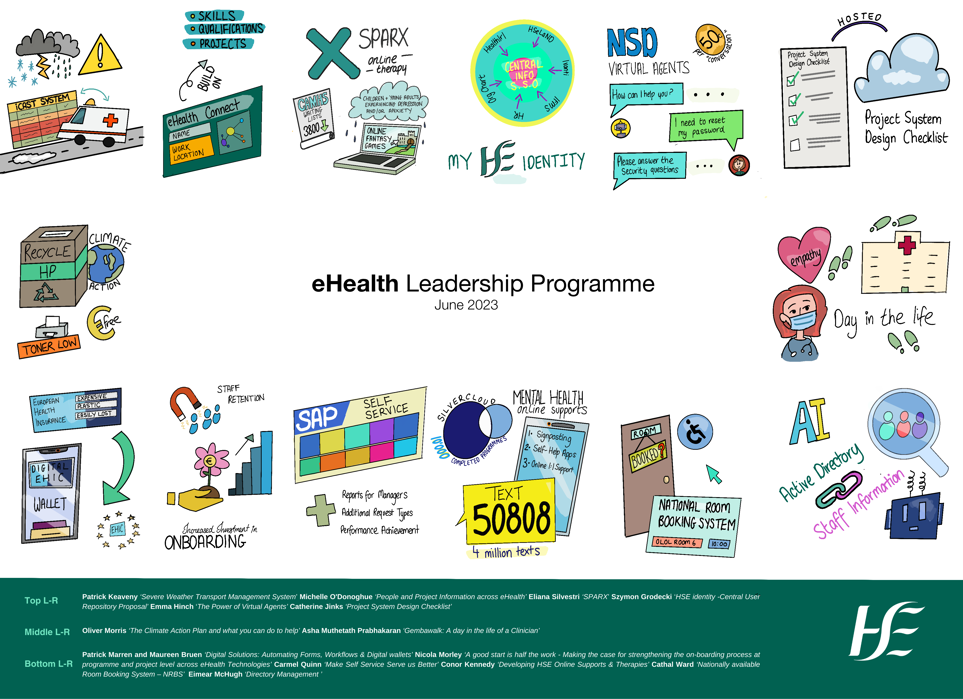
eHealth Leadership Programme
On Wednesday 21st of June we gathered at the Richmond Education and event centre in Dublin for our Leadership Development programme presentations. This event gave the fifteen participants the opportunity to use their new knowledge and skills acquired over the 6-month training programme to present a proposal to the senior
management team of eHealth. We were very excited and impressed with all the brilliant ideas and innovations aiming to improve the everyday workings of eHealth for our HSE staff and patients.
Patrick Keaveny examined our past safety measure response to transport during periods of severe weather and proposed ‘Icast’, a software that allows both staff and clients to request transportation to work or appointments. This presentation was a fresh look at the steps we can take to guarantee the welfare of our staff and clients during times of unprecedented conditions, during which our usual services are unable to function. The presentation was titled ‘Severe Weather Transport Management System’.
Eliana Silvestri’s presentation is a response to the much-needed services for young people in Ireland suffering with their mental health. ‘Sparx’s’ aim is to enhance positive mental health in children and young adults through e-therapy. This free online computer game uses CBT (Cognitive Behavioural Therapy) to help young people with mild to moderate depression, stress, or anxiety. It could be provided to young people in Ireland for free, with the plan to alleviate pressures of waiting lists and services while also providing instant treatment to young people struggling who cannot afford to wait.
Eimear McHugh’s ‘Directory Management’ is an active directory to access the movement of staff within eHealth. The proposed system would be a source to identify joiners, movers, and leavers within eHealth. Controlled by AI and BOTT technology, it has the potential to identify missing information as well as producing user alerts.
Michelle O’Donoghue’s title of ‘People and Project Information across eHealth’ is a web-based tool built using Microsoft Bi which enables staff to view and interact with the network navigator style org chart and also find eHealth contact information.
Emma Hinch’s ‘The Power of virtual Agents’ proposed an AI operated helpdesk to solve minor technical issues. Using chatbot software, it is possible to use the technology already present in day-to-day operations. This technology would result in stable 24/7 responses, cost and time savings on our helpdesk and continuous development.
Catherine Jinks’ ‘Project System Design Checklist’ will ‘enable efficiency, reduces risks, and enhances user experience’ across eHealth staff. This concise and clear system will provide all information, objectives and documents needed for the project and strives to avoid common last-minute misunderstandings or miscommunications.
Conor Kennedy: Developing HSE Online Supports & Therapies: Care Closer to Home. Conor identified 3 layers of HSE-funded online supports including information and signposting, online self-help supports, and online person to-person supports, and outlined case studies of same developed and/or operated by HSE staff, or through HSE funded agencies, their impact, and suitability for scaling. Conor proposed the establishment of a function and processes to support the scaling and mainstreaming of these supports with 6 key components including security & data protection, procurement, evaluation, and internal and public communications.
Establishing and resourcing this function would maximize the return on HSE investment, ensure equity of access to high quality and safe supports across the country, and support and encourage innovation across the service.
Oliver Morris: The Climate Action Plan and what you can do to help. This proposal suggested small but impactful changes to implement within eHealth to join the fight against climate change. Oliver highlighted the detrimental effect to the environment printer cartridges pose and highlighted an effective and free recycling system of cartridges in partnership with HP Planet Partners. With this, eHealth is doing our bit to cut down on the 375 million empty cartridges ending up in landfills each year.
Gembawalk: A Day in the life of a Clinician by Asha Prabhakaran strives to make the hectic life of a clinician that bit easier. This is pre-planned, intentional time with clinicians to learn and understand their current tasks and issues. This helps all eHealth staff to understand the real-life, real-time problems clinicians face while working with patients and highlights the need for effective and efficient technologies.
Szymon Grodecki introduced My HSE Identity Service. This central user repository proposal gives each individual working in the HSE a portal to display and find personal data such as contact info, documents and training and compliance data etc.
Nicola Morley A Good Start is Half the Work: Making the case for strengthening the on-boarding and induction process at programme and project level across eHealth Technologies. The goal of this presentation is to support new staff to settle into their new role, learn quicker and more efficiently and reduces stress and increase job satisfaction for staff. This can improve new starter retention by over 80% and increase productivity by 70%.
Patrick and Maureen’s ‘Digital Solutions’ included automated forms, workflows, and digital wallets. With the move of flight tickets, debit cards and memberships from hardcopy to instantly accessible on your smartphone, their idea suggests taking the transformation that bit further. This proposal suggests cards such as EHIC, passports, work IDs as well as medical cards (organ donor, blood donor) should be available in your digital wallet. This would cut down on loss of items, as well as cost savings environmental benefits and efficiency.
Cathal Ward’s presentation focused on a nationally available room booking system. (NRBS) The creation of this electronic system to support room bookings across
all HSE. As there is no visibility of available rooms for events, training, meetings etc. this would be a solution that provides realtime access to facilities, reduces manual intervention, and creates standardised approach.
Carmel Quinn, suggested ‘Making Self Service Serve us Better’. This idea aims to enhance functionality of SAP, including leave application forms, HR forms, Timesheets,
qualifications etc. Documents such as application of annual leave, carers leave, maternity leave, parental leave etc. as well as reports - employee analysis Report, employee quota’s report. And positions: Occupied & Unoccupied. This reduces errors, more complete HR data and allows a single point of access.
We would like to thank all our amazing participants for their time, effort and determination to this programme. We would also like to thank all our Senior Management Team and guests for taking the time to attend, listen and engage.
Below is an artistic representation of the projects presented on the day by Kate Hanlon.

